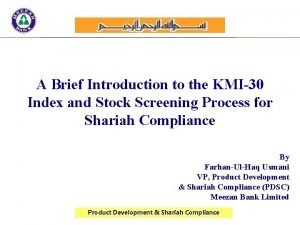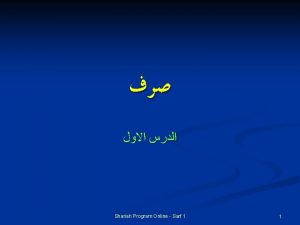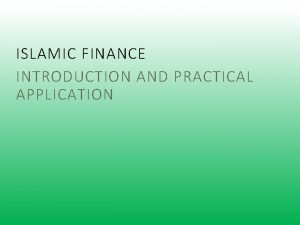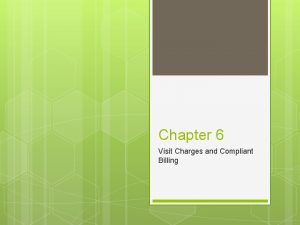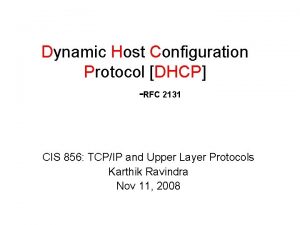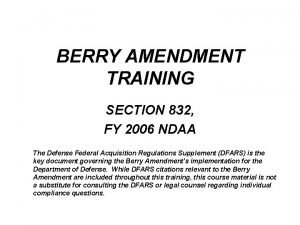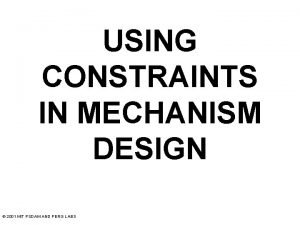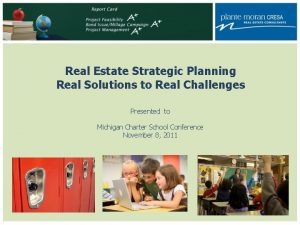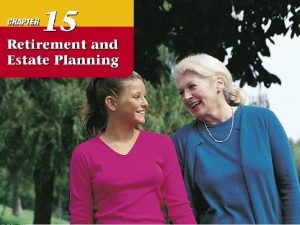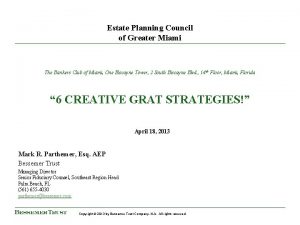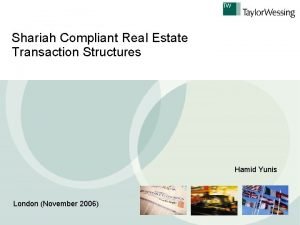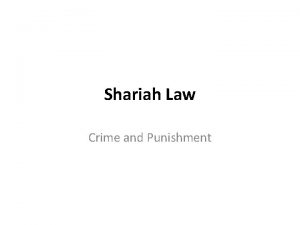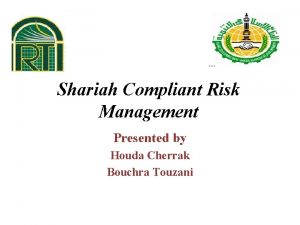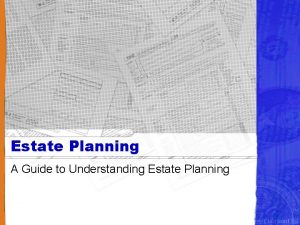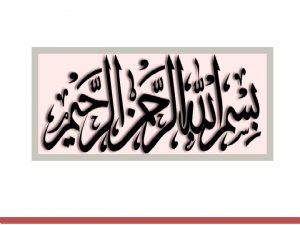A PRACTICAL APROACH TO SHARIAH COMPLIANT ESTATE PLANNING






























- Slides: 30

A PRACTICAL APROACH TO SHARI’AH COMPLIANT ESTATE PLANNING FISA – AUGUST 2018 HOLISTIC ESTATE PLANNING

Contents Ø Introduction Ø Basis of Islamic inheritance Ø Estate Planning in relation to Shari’ah Law

Islamic Inheritance Ø Introduction Ø Compliance Ø Sources of Islamic Law Ø Primary - Quran Ø Secondary ØNarrations of the Prophet (S. A. W) ØIjma (consensus by Islamic Scholars)

Basis of Islamic inheritance Ø Quran Ø “Allah (thus) directs you as regards your Children's (Inheritance): to the male, a portion equal to that of two females: if only daughters, two or more, their share is two-thirds of the inheritance; if only one, her share is a half. For parents, a sixth share of the inheritance to each, if the deceased left children; if no children, and the parents are the (only) heirs, the mother has a third; if the deceased Left brothers (or sisters) the mother has a sixth. (The distribution in all cases ('s) after the payment of legacies and debts. Ye know not whether your parents or your children are nearest to you in benefit. These are settled portions ordained by Allah; and Allah is All-knowing, Al-wise. ” Al Nisa, Verse 11 Ø “In what your wives leave, your share is a half, if they leave no child; but if they leave child, ye get a fourth; after payment of legacies and debts. In what ye leave, their share is a fourth, if ye leave no child; but if ye leave a child, they get an eighth; after payment of legacies and debt, if the man or woman whose inheritance is in question, has left neither ascendance or descendants(kalalah), but has left a brother or a sister, each one of the two gets a sixth. Should there be more than two, they share one third after payments of legacies and debts. This is stipulated so that no loss is caused (to any one). Thus is it ordained by Allah, and Allah is All-Knowing and Most Forbearing. ” Al Nisa verse 12

Basis of Islamic inheritance (cont. ) Ø Quran (cont. ) Ø “They ask thee for a legal decision. Say: Allah directs (thus) about those who leave no descendants or ascendants as heirs. If it is a man that dies, leaving a sister but no child, she shall have half the inheritance: if (such a deceased was) a woman, who left no child, her brother takes her inheritance: if there are two sisters, they shall have twothirds of the inheritance (between them): if there are brothers and sisters, (they share), the male having twice the share of the female. Thus doth Allah make clear to you (His law), lest ye err. And Allah hath knowledge of all things. ” Al Nisa verse 176

Basis of Islamic inheritance (cont. ) Ø The Quranic verses spell out: Who should inherit How much they should inherit How one may inherit How one heir blocks / excludes another heir from inheriting Ø That males will receive double the share of females Ø Ø

Basis of Islamic inheritance (cont. ) Narrations of the prophet Ø Aboo Hurayrah (PBUH) reported that the messenger of Allah (S. A. W) said: “if a child utters a sound (after being born) in inherits” Ø The prophet (S. A. W) gave judgement in the case where the deceased leaves behind a daughter, daughter of a son and a sister: “the daughter receives (inherits) one-half, the daughter of the son receives (inherits) 1/6 and the residue is for the sister”

Order of rights to estate Islamic Jurists concur rights are graded in the following order: Ø Funeral Expenses Ø Debts ØReligious Obligations ØOthers Ø Wasiyyah (Legacy) Ø Balance to heirs (Inheritance) ØPrescribed / fixed shares ØResidual shares

Wasiyyah & Inheritance Wealth Funeral Expenses & Debts Estate Wasiyyah • In terms of Instructions Inheritance • In terms of Quraan

Wasiyyah - Legacy Ø It is a bequest or an instruction in a Will Ø Concept confirmed in Islamic Law Ø Our prophet Muhammad (PBUH) had said: Ø “Truly Allah had given you a sadaqah (charity) of one third of your entire wealth that serves as an increment to your deeds. Place it wherever you want to or (give it) to whomsoever you like” reported by Bukhᾱriy Ø Can consist of money, assets, benefits, usufruct over assets. Ø Can include instructions i. r. o. burial arrangements, conduct of life by heirs, etc.

Wasiyyah – Legacy (cont. ) Ø Cannot exceed 1/3 of persons estate after expenses (funeral, debt etc. ) Ø Those who benefit as heirs i. t. o surah Al-Nisa cannot again benefit out of this 1/3 allocation Ø If any Quranic heirs are blocked / excluded then they can benefit from the 1/3 allocation. Ø Non-muslims and charities can benefit Ø The bequest / instructions is implemented after death Ø Can be changed any time before death

Inheritance Estate Wasiyyah Inheritance Prescribed /Fixed Shares Residual Shares

Inheritance Estate Wasiyya / Legacy Inheritance Prescribed / Fixed Shares Residual Shares

Inheritance (cont. ) Ø Based on relatives alive on date of death Ø Know family relationships well; as different relationships have different effects Ø Deprived relatives Ø Ø Adopted child Ex-wife Illegitimate child Non-Muslim Ø Understand blocking / excluding principle Ø Allocation in terms of: Ø Prescribed / fixed shares Ø Residual shares

Prescribed / Fixed shares (in relation to the deceased) Ø Ø Ø Ø Ø Husband – 1/4 , 1/2 * Wives – 1/4 , 1/8* Daughters – 1/2 , 2/3* Father – 1/6* Mother – 1/6, 1/3* Granddaughters – 1/2 , 2/3 Grandfather – 1/6 Grandmothers – 1/6 Sisters – 1/2 , 2/3 * Cannot be screened (blocked) See annexure for details

Prescribed / Fixed shares explained (in relation to the deceased) Husband Ø Possible shares Wives Ø Possible shares Ø 1/2 – No Children Ø 1/4 – Has Children Ø 1/4 – No Children Ø 1/8 – Has Children Ø Confirmed Share Ø Cannot be blocked / excluded

Prescribed / Fixed shares explained (cont. ) (in relation to the deceased) Father Mother Ø Possible minimum shares Ø 1/6 – No Children Ø Confirmed Share Ø Cannot be blocked / excluded Ø Blocks / excludes Ø Grandparents Ø Siblings Ø Nephews & their sons Ø 1/3 – No Children Ø 1/6 – Has Children or multiple siblings Ø Confirmed Share Ø Cannot be blocked / excluded Ø Blocks / excludes Ø Both grandmothers

Prescribed / Fixed shares explained (cont. ) (in relation to the deceased) Grandfather Grandmother Ø Possible shares Ø 1/6 Ø Conditions Ø Absence of a father Ø Blocks / excludes Ø Nephews & their sons Ø 1/6 Ø Conditions Ø Absence of a mother Ø Absence of a father Ø Exception for maternal grandmother

Prescribed / Fixed shares explained (cont. ) (in relation to the deceased) Daughters Granddaughters (only from son) Ø Possible shares Ø 1/2 – 1 daughter Ø 2/3 – Multiple daughters Ø Conditions Ø Absence of a son Ø Confirmed share Ø Cannot be blocked / excluded Ø 1/2 – 1 granddaughter Ø 2/3 – multiple granddaughters Ø 1/6 – 1 daughter Ø Conditions Ø Absence of multiple daughters Ø Absence of son

Prescribed / Fixed shares explained (cont. ) (in relation to the deceased) Sisters Ø Possible share Ø 1/2 – 1 sister Ø 2/3 – multiple sisters Ø Conditions Ø Absence of a daughter / granddaughter Ø Absence of a brother Ø Absence of father / grandfather

Residual Shares (in relation to the deceased) Ø Once the Quranic prescribed / fixed shares have been determined in terms of their proportions, the residual shares (balance / taseeb) is allocated Ø 2: 1 ratio for male and female Ø Priority / Ranking (taseeb) Ø Ø Ø Sons & daughters Grandsons & Granddaughters Father Brothers & Sisters Nephews & their sons Uncles & their sons Ø It is possible to get a share through prescribed / fixed shares and through residual shares

The Common Clause I appoint as the heirs of the whole of my Estate my heirs in accordance with Islamic Law, provided that the effect of this clause, and the portion of my Estate each of my heirs are each to receive shall be certified by an expert in that Law, or qualified Islamic theologian, or a non-profit organisation which, in the ordinary course of their operations provide such certificates, appointed by my Executors in their entire discretion and such certification shall be proof of the dictates of Islamic Law in this regard

Inheritance Calculators: http: //inheritance. ilmsummit. org http: //www. islamicsoftware. org/irth. html Ø See table Ø Complete Ø Click calculate

Illustration with Examples Heirs / Beneficiaries in relation to deceased (male) Wife, 1 son & 2 daughters Wife, 1 son, 2 daughters & parents (12. 5%) Wife, 2 daughters (son predeceased leaving a son) Wife 1/8 (12. 5%) 1/8 Mother 1/6 (16. 67%) Deceased Father 1/6 (16. 67%) Deceased Son 13/48 (27. 08%) 7/16 Deceased 7/12 Daughter 1 13/96 (13. 54%) 7/32 (21. 88%) 2/6 (33. 34%) Deceased Daughter 2 13/96 (13. 54%) 7/32 (21. 88%) 2/6 (33. 43%) 7/24 Son of Son N/B 5/24 (20. 83%) 0% Son of Daughter 1 N/B N/B (43. 75%) 1/8 (12. 5%) Wife, 1 son, 1 daughter (daughter predeceased, leaving 1 son ) Colour coded: Fixed Residual (N/B – not born yet) Not applicable 1/8 0% (12. 5%) (58. 33%) (29. 17%)

Special Cases Ø Ø Ø Ø Ø Simultaneous deaths Missing person Adopted children Step Children Multiple wives Aul / Radd adjustments Reverts (embracing Islam) Foetus Divorce Absence of Standard heirs

Issues to be considered in your Estate Plan Ø Will Issues Ø Provision for descendants of heirs who may predecease you Ø Contributions to PBO’s Ø In respect of minor children Ø Nomination of guardians Ø Nomination of Trust and Trustees Ø Recognise challenges i. r. o. apportionment of assets Ø Include a redistribution clause Ø Other Issues Ø Ø Ø Ø Effect of different marital status’ Use of usufructs Use of Trusts The management of loan assets Partnership and shareholding arrangements Life insurance policy pay-outs Pension / Provident / Retirement Annuity Funds pay-outs

Issues to be considered in your Estate Plan Ø Improving the position of spouse Ø Keep proper records of each spouse’s contribution towards the acquisition of assets Ø Record ownership in correct person’s name / jointly / or strategically in spouse name Ø Award contribution recognition to spouse e. g. House; this will increase estate’s liabilities on death Ø Recognise your spouse’s efforts and allocate monetary amounts per month to it; on cumulative basis this increases estate liabilities and her share of the estate Ø Create usufructs in favour of your spouse over any asset which is deemed to be a necessity during your lifetime or in your Will Ø Consider transferring assets to your spouse during your lifetime; no punitive taxes (for property this may incur transfer duty. ) Ø Reducing death costs Ø Consider transferring assets to heirs in your lifetime to the extent that you can Ø Use your R 100 k donations allowance per annum Ø General Ø Consider using a Trust mechanism for the benefit of spouse and children in your lifetime

Apportionment of Assets – a challenge Heirs / Beneficiaries in relation to deceased (male) Wife House R 1, 000 Car R 100, 000 Investments R 100, 000 Insurance Policies ? ? ? Share (100%) 1/8 Inheritance Value R 1, 200, 000 R 150, 000 Total Allocated Difference (12. 5%) Son Daughter 7/16 (43. 75%) 7/32 (21. 88%) R 525, 000 R 262, 500

Trusts Ø From a shari’ah perspective an Inter Vivos Family Trust is an extension of the planner Ø During the lifetime of the planners, the beneficiaries may benefit from Trust at the discretion of the Trustees Ø On the death of the planner, the shari’ah apportionment of assets must be dealt with Ø The trust deed must make provision for this Ø Clear guidance must be spelt out as to how the assets are going to be distributed / managed by Trustees in these circumstances Ø Founder may benefit from Trust assets and may also apportion benefits to beneficiaries

THANK YOU & QUESTIONS
 Kmi30
Kmi30 Harris sarf
Harris sarf Riba an nasiyya
Riba an nasiyya Compliant billing
Compliant billing Compliant victimization
Compliant victimization Cfr 21 +tem
Cfr 21 +tem Cts hdcp
Cts hdcp Sarbanes oxley email retention
Sarbanes oxley email retention Www.fors-online.org.uk
Www.fors-online.org.uk Dhcp protocol rfc
Dhcp protocol rfc Fors and clocs compliance
Fors and clocs compliance Scorm compliant authoring tool
Scorm compliant authoring tool Inkoop manager inleen
Inkoop manager inleen Berry amendment exceptions list
Berry amendment exceptions list Compliant mechanism
Compliant mechanism Consumer traits
Consumer traits Becoming hipaa compliant
Becoming hipaa compliant Twic card authentication & validation
Twic card authentication & validation Chicago estate planning council
Chicago estate planning council Estate planning council of birmingham
Estate planning council of birmingham Strategic planning real estate
Strategic planning real estate Omaha estate planning council
Omaha estate planning council Resident alien telluride
Resident alien telluride Chapter 15 retirement and estate planning
Chapter 15 retirement and estate planning Palos verdes estate planning
Palos verdes estate planning Estate planning council of greater miami
Estate planning council of greater miami Family limited partnership
Family limited partnership Secu virginia
Secu virginia Ministry estate planning
Ministry estate planning Montgomery county estate planning council
Montgomery county estate planning council Long medium and short term planning in primary schools
Long medium and short term planning in primary schools
